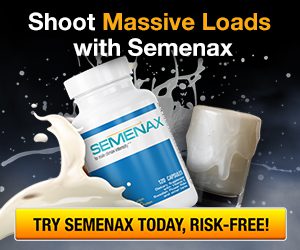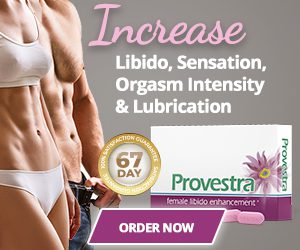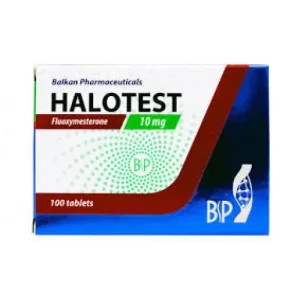Steroids
The Ultimate Chain and Plate Curls for Pumping Biceps

Chain and plate curls can be effective exercises to target and develop your biceps, particularly if you are an experienced lifter looking to add variety to your arm training routine. These exercises can help provide a unique stimulus to your biceps muscles and contribute to their growth. Here's how to perform chain and plate curls for better biceps.
Chain Curls:
- Setup: This exercise requires a pair of chains and a barbell. Begin by draping the chains over the barbell and loading it with weight plates on both sides. The chains should hang down evenly.
- Grip: Stand with your feet shoulder-width apart and grip the barbell with an underhand (supinated) grip, hands spaced about shoulder-width apart.
- Curl: Start with your arms fully extended and the chains just off the ground. Curl the barbell toward your chest while keeping your elbows close to your sides and back straight.
- Squeeze: At the top of the movement, squeeze your biceps for a second to maximize the contraction.
- Lower: Slowly lower the barbell back to the starting position, allowing the chains to return to the ground.
- Repetition: Perform 3-4 sets of 8-12 reps. You can adjust the weight by adding or removing plates from the barbell to match your strength level.
Plate Curls:
- Setup: For plate curls, you'll need a weight plate with a hole in the center. Stand with your feet shoulder-width apart, and hold the plate with both hands through the hole, allowing the plate to hang below your hands.
- Grip: Hold the plate with a supinated (underhand) grip and extend your arms fully.
- Curl: Curl the plate toward your chest while keeping your elbows close to your sides.
- Squeeze: At the top of the movement, contract your biceps and hold for a second.
- Lower: Slowly lower the weight plate, fully extending your arms.
- Repetition: Perform 3-4 sets of 8-12 reps.
Remember to use proper form, control the weight, and focus on the mind-muscle connection during these exercises. Ensure you gradually increase the weight as you progress to continue challenging your biceps for growth. Additionally, incorporate these exercises into your overall arm training routine, which should include a variety of biceps and triceps exercises for balanced arm development.
Related Article: Bodybuilding Protein Cycling for Massive Gains
Biceps Secrets Only Elite Bodybuilders Know
Elite bodybuilders often have a combination of genetics, discipline, and training knowledge that contributes to their exceptional bicep development. While there are no "secrets" per se, there are several key principles and strategies that elite bodybuilders use to build impressive biceps:
Consistent Progressive Overload
To stimulate muscle growth, you need to increase the weight you lift over time progressively. Elite bodybuilders consistently challenge themselves by lifting heavier weights or performing more reps with the same weight. This helps break plateaus and stimulate muscle growth.
Varied Training Methods
Elite bodybuilders incorporate various bicep exercises into their routines to target the muscles from different angles. This includes curls, hammer curls, preacher curls, and concentration curls, among others.
Proper Form
Maintaining strict form during bicep exercises is crucial. Elite bodybuilders prioritize strict, controlled movements to ensure that they are targeting the biceps and minimizing the involvement of other muscle groups.
Mind-Muscle Connection
Elite bodybuilders focus on establishing a strong mind-muscle connection with their biceps. This means they are mentally present during each repetition, concentrating on the contraction and stretch of the biceps throughout the exercise.
Nutrition
Proper nutrition is essential for muscle growth. Elite bodybuilders ensure they are in a caloric surplus to support muscle growth, and they pay attention to their macronutrient intake, ensuring an adequate amount of protein for muscle repair and growth.
Supplementation
Some elite bodybuilders use supplements like protein powder, creatine, and branched-chain amino acids (BCAAs) to support their muscle-building efforts. However, supplements should complement a well-balanced diet, not replace it.
Adequate Rest and Recovery
Muscle growth happens during periods of rest, not during the workout itself. Elite bodybuilders prioritize sleep and allow sufficient time between workouts targeting the same muscle group to ensure full recovery.
Volume and Frequency
Elite bodybuilders typically incorporate high-volume and high-frequency training into their routines. This means more sets and reps for the biceps and often hitting the biceps multiple times per week.
Periodization
Periodization involves cycling through different training phases, such as strength, hypertrophy, and endurance. Elite bodybuilders use periodization to ensure their training stays varied and effective.
Genetics and Patience
It's important to recognize that genetics play a significant role in muscle development. Elite bodybuilders understand their genetic potential and work patiently to maximize it over years of consistent training.
Professional Guidance
Some elite bodybuilders work with coaches or trainers who can provide expert training, nutrition, and supplementation guidance.
Motivation and Consistency
Elite bodybuilders are highly motivated and maintain consistency in their training and nutrition. They stay dedicated to their goals over the long term, which is crucial for building impressive muscle mass.
Understanding that what works for elite bodybuilders may not be suitable for everyone is essential. Your training and nutrition plan should be tailored to your goals, genetics, and individual preferences. Consulting with a qualified fitness professional or coach can help you develop a personalized plan for building your biceps and achieving your bodybuilding goals.
Must Read: Testosterone Propionate Cycles Solo cycle
Why A Biceps Pump Is Crucial Before A Contest
In the lead-up to a bodybuilding competition, bodybuilders often go through a specific "cutting" or "pre-contest" phase. During this phase, the primary goals are to reduce body fat to showcase muscle definition and ensure that the biceps and other muscles look their best on stage. Here's a sample training and nutrition cycle for the biceps in the weeks leading up to the competition:
Training:
- High-Volume Workouts: Bodybuilders typically continue to train biceps with high volume to maintain and even improve muscle fullness and separation. This may involve multiple exercises and sets targeting the biceps.
- Mind-Muscle Connection: Focus on establishing a strong mind-muscle connection during bicep workouts. Ensure you're feeling the bicep muscles working with each repetition.
- Drop Sets and Supersets: Introduce techniques like drop sets and supersets to intensify workouts and stimulate muscle definition.
- Frequency: Continue to train biceps at least once a week. Depending on your program, you may perform biceps exercises on the same day as back training or in a separate workout.
- Progressive Overload: Maintain or slightly decrease the weight used to emphasize form and muscle contraction while increasing the number of reps and sets.
Nutrition:
- Caloric Deficit: Bodybuilders typically aim for a caloric deficit to reduce body fat during the pre-contest phase. A moderate, sustainable calorie deficit is essential to avoid muscle loss.
- Macronutrient Balance: Continue prioritizing protein intake to support muscle retention and repair. Carbohydrate intake may be adjusted depending on individual preferences and energy needs, but monitoring and adjusting this carefully is important.
- Balanced Diet: Consume a well-balanced diet that includes lean protein sources, complex carbohydrates, healthy fats, and plenty of micronutrients from vegetables and fruits.
- Meal Timing: Some bodybuilders succeed with smaller, more frequent meals to help maintain energy levels and control hunger.
- Hydration: Stay adequately hydrated, as dehydration can negatively affect muscle definition.
- Supplementation: Continue with your usual supplementation plan, which may include vitamins, minerals, and possibly thermogenic supplements. Consult with a healthcare professional or nutritionist for personalized advice.
- Cheat Meals: Some bodybuilders incorporate occasional cheat meals to help psychologically manage the rigors of a strict diet. These should be controlled and not lead to excessive calorie surplus.
- Monitoring: Track your progress by tracking body weight, fat percentage, and physical changes. Adjust your diet and exercise program as needed based on these measurements.
Recovery:
- Adequate Sleep: Prioritize sleep to support recovery and minimize muscle catabolism.
- Active Recovery: Incorporate light, low-impact activities such as walking or swimming on rest days to aid recovery and maintain a calorie deficit.
Biceps Hacks For Intermediate and Beginner Bodybuilders
To maximize biceps development and help bodybuilders achieve impressive arm size and definition, here are some effective "hacks" or strategies to consider:
-
Train With Proper Form:
- Use strict form to ensure that your biceps are the primary muscles engaged during biceps exercises.
- Avoid using momentum, swinging, or jerking to lift the weight. This reduces the effectiveness of the exercise and increases the risk of injury.
-
Focus on the Mind-Muscle Connection:
- Concentrate on feeling the biceps contract during each repetition. This enhances muscle engagement and helps you develop a better mind-muscle connection.
- Visualize your biceps working with every rep, and try to feel the muscle stretching and contracting.
-
Variety of Biceps Exercises:
- Incorporate a range of biceps exercises, such as barbell curls, dumbbell curls, hammer curls, preacher curls, concentration curls, and cable curls.
- Vary your exercises to target the biceps from different angles and prevent plateaus.
-
Utilize Advanced Techniques:
- Techniques like drop sets, supersets, and negatives can intensify your biceps workouts and stimulate growth.
- Experiment with partial reps and isometric contractions to challenge your biceps differently.
-
Adjust Hand Positions:
- Changing your hand position can alter the emphasis on different parts of the biceps. For instance, a wide grip on a barbell curl may work the outer biceps more, while a narrow grip can emphasize the inner biceps.
-
Pre-Fatigue Techniques:
- Begin your workout with isolation exercises like concentration curls or cable curls to pre-fatigue the biceps. This can make compound movements more effective for growth.
-
Proper Warm-up:
- Warm up the biceps with light weights or resistance bands to increase blood flow and reduce the risk of injury.
-
Use Wrist Straps Sparingly:
- While wrist straps can help you lift heavier weights, try to use them sparingly. Building grip strength can indirectly benefit your biceps development.
-
Nutrition and Recovery:
- Consume a well-balanced diet with adequate protein, healthy fats, and carbohydrates to support muscle growth.
- Ensure you get enough rest and recovery to allow your muscles to repair and grow.
-
Supplementation:
- Some bodybuilders use supplements like creatine and branched-chain amino acids (BCAAs) to support their muscle-building efforts. Consult with a healthcare professional or nutritionist before adding supplements to your routine.
-
Periodization:
- Incorporate periodization into your training plan to cycle between different phases of intensity and volume, such as strength, hypertrophy, and endurance.
-
Stay Consistent:
- Consistency is key in bodybuilding. Stick to your training and nutrition plan over the long term to see substantial results in biceps development.
-
Consult a Coach or Trainer:
- If you're serious about your bodybuilding goals, consider working with a coach or trainer who specializes in bodybuilding to provide expert guidance and personalized advice.
Does Testosterone Play A Role In Biceps Development?
Testosterone is an essential hormone for muscle development in both men and women, and it plays a role in the growth and maintenance of all skeletal muscles, including the biceps. Here's how testosterone influences bicep muscle development:
Protein Synthesis
Testosterone increases the rate of protein synthesis in muscle tissue. Protein synthesis is the process by which the body builds new muscle proteins and repairs damaged ones. This is a key mechanism for muscle growth.
Muscle Fiber Hypertrophy
Testosterone can lead to muscle fiber hypertrophy, which means individual muscle fibers increase in size. This results in larger and stronger muscles, including the biceps.
Reducing Muscle Breakdown
Testosterone can help reduce the rate of muscle protein breakdown, meaning your muscles are better protected against catabolism (muscle loss).
Increased Training Intensity
Testosterone is associated with increased motivation and energy levels, which can lead to more intense and productive workouts. This can contribute to better muscle development, including the biceps.
Bone Health
Strong, healthy bones are essential for supporting muscle growth. Testosterone helps maintain bone density, which indirectly supports muscle development.
Androgen Receptors
Testosterone binds to androgen receptors on muscle cells, initiating processes that promote muscle growth and repair.
It's important to note that while testosterone is a key factor in muscle development, it's not the only factor. Nutrition, training, genetics, and other hormones also play significant roles. Additionally, the impact of testosterone on muscle growth varies from person to person, as individuals have different levels of natural testosterone production and androgen receptor sensitivity.
For those looking to optimize their bicep and overall muscle development, it's essential to maintain a balanced and healthy lifestyle:
- Strength Training: Engage in a structured strength training program that includes exercises specifically targeting the biceps, such as curls and variations of curls.
- Proper Nutrition: Consume a well-balanced diet with sufficient protein, carbohydrates, and healthy fats to support muscle growth and recovery.
- Adequate Rest: Allow your muscles time to recover and grow by getting enough sleep and incorporating rest days into your workout routine.
- Stress Management: High levels of chronic stress can negatively impact testosterone levels, so managing stress is crucial.
- Consultation with Healthcare Professionals: If you suspect a hormone imbalance or have concerns about testosterone levels, it's essential to consult with a healthcare professional or endocrinologist. They can guide appropriate interventions or treatments.
Overall
It's crucial to remember that individual responses to training and nutrition can vary significantly. Therefore, working with a coach or nutritionist experienced in pre-contest preparation can help you fine-tune your approach and optimize your bicep development and overall physique for a bodybuilding competition. Additionally, it's essential to tailor your program to your specific needs, body type, and goals.
Genetics also affect muscle development, so your results may vary. What works best for you might require some experimentation and adjustment. Always prioritize safety, proper technique, and gradual progression in your biceps training.
Read More: Horse Chestnut and Other Supplements to Get Rid of Water Retention
Steroids
Creatine vs Myostatin: An Expert’s Analysis
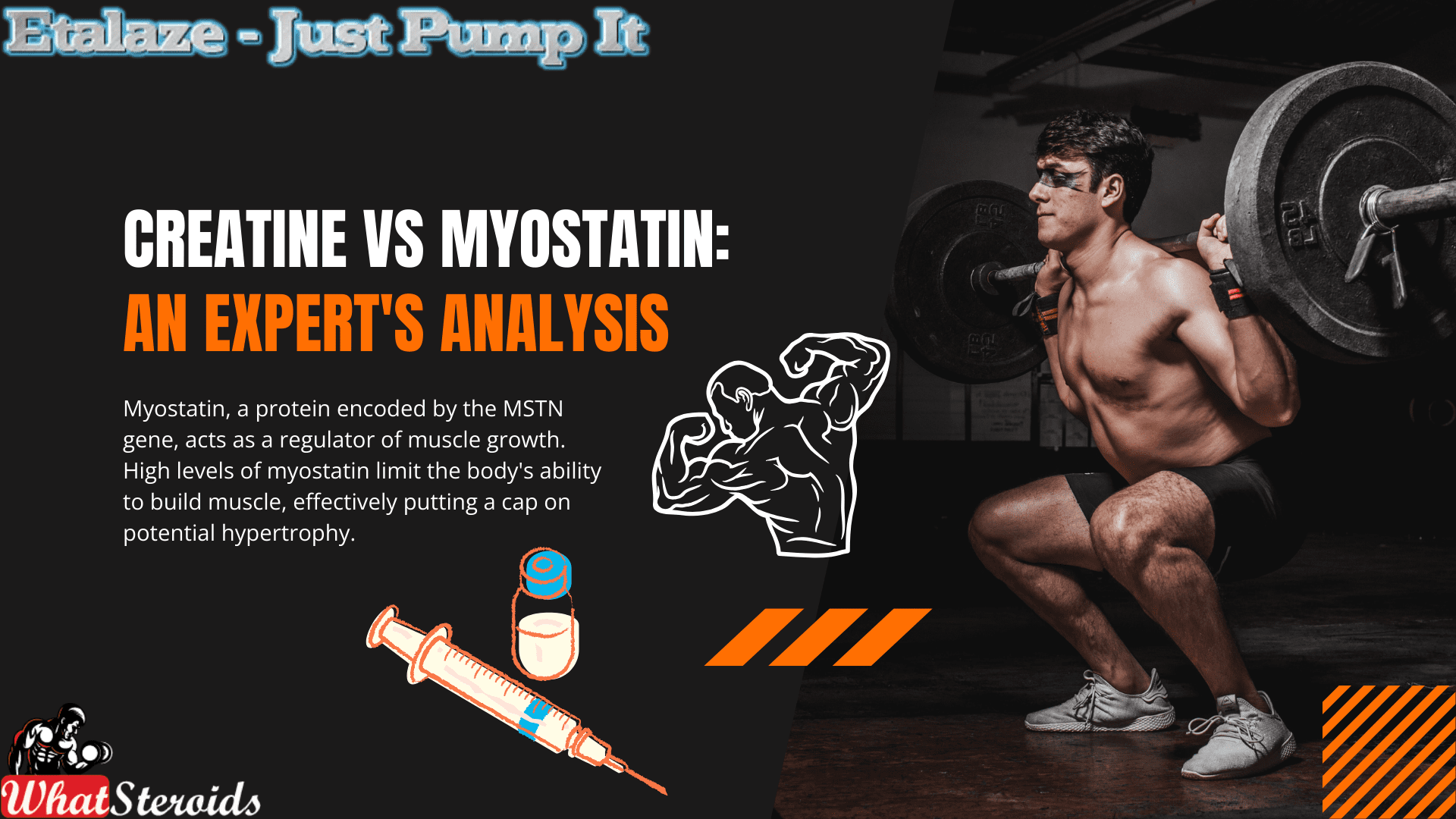
Myostatin, a protein encoded by the MSTN gene, acts as a regulator of muscle growth. High levels of myostatin limit the body's ability to build muscle, effectively putting a cap on potential hypertrophy. Inhibiting myostatin has become a focal point for bodybuilders looking to break through plateaus and achieve significant muscle gains. The question is: can creatine, a popular and widely available supplement, help in this regard?
Medical History of Myostatin and Creatine
Myostatin and creatine, while popular now in the bodybuilding world, have their roots in entirely different contexts:
Myostatin: Natural Muscle Growth Regulator
Myostatin is a protein originally identified for its role in regulating skeletal muscle mass. In nature, it serves an evolutionary purpose: by limiting muscle growth, it conserves energy, ensuring that animals (and humans) don’t expend unnecessary resources maintaining excessive muscle tissue. This was especially important in the wild, where energy efficiency could mean the difference between survival and extinction.
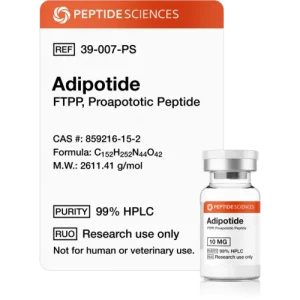 Check Adipotide (FTPP) 10mg by Peptide Science
Check Adipotide (FTPP) 10mg by Peptide Science
In the medical field, research into myostatin has focused on its role in muscle-wasting diseases. Scientists are exploring ways to inhibit myostatin to treat conditions like muscular dystrophy, where excessive muscle loss impairs quality of life. This therapeutic potential is where the idea of myostatin inhibition first began—long before bodybuilders latched onto the concept.
Creatine: Energy and Medical Applications
Creatine was originally studied for its role in energy metabolism. It’s a naturally occurring compound stored in muscle cells and plays a critical part in replenishing ATP (adenosine triphosphate), the body’s primary energy currency during short, high-intensity activities.
Before becoming a bodybuilding staple, creatine gained recognition in medical and sports science for its ability to improve athletic performance and assist with recovery. Furthermore, in medicine, creatine was investigated for neurological conditions such as Parkinson’s disease, Huntington’s disease, and muscular dystrophy, given its potential to improve muscle function and brain energy metabolism.
In the sports world, it was initially adopted by sprinters and weightlifters in the 1970s and 1980s for its energy-enhancing benefits.
Both myostatin and creatine have found new life in bodybuilding circles, demonstrating how discoveries in natural physiology and medical science can lead to transformative applications in fitness.
Benefits of Creatine as a Myostatin Inhibitor
Muscle Growth Potential: Research suggests that creatine, when paired with intense resistance training, may inhibit myostatin to a degree, fostering an environment for enhanced muscle growth.
Improved Exercise Performance: Creatine is well-known for its ability to increase ATP production, translating to better performance during high-intensity activities.
Versatility Across Fitness Levels
Whether you're a beginner or an advanced athlete, creatine offers benefits that complement various stages of muscle-building.
Must Read: A New Caffeine? What You Need to Know about Teacrine
Affordability and Accessibility
Compared to specialized myostatin inhibitors like YK-11 and ACE-031, creatine is significantly more affordable and accessible.
Side Effects of Creatine
While generally safe for most individuals, creatine supplementation does come with some potential side effects:
Water Retention: Some users experience bloating due to increased water retention in muscle cells.
Gastrointestinal Issues: High doses may lead to stomach upset or diarrhea.
Kidney Concerns: Although rare, prolonged excessive use could strain the kidneys, particularly in individuals with pre-existing conditions.
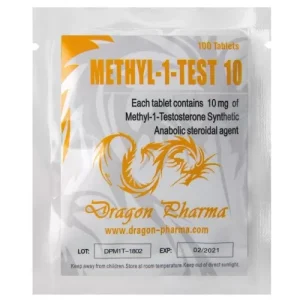 Buy Methyl-1-Test 10 -100 tabs by Dragon Pharma
Buy Methyl-1-Test 10 -100 tabs by Dragon Pharma
Alternatives to Creatine for Myostatin Inhibition
YK-11: A synthetic myostatin inhibitor derived from SARMs, offering more potent results but accompanied by more significant risks.
ACE-031: A peptide that directly inhibits myostatin, though it remains in experimental phases and is not legally approved in many regions.
Natural Alternatives
Follistatin-rich Foods: Eggs and dairy products may have natural myostatin-inhibiting properties.
Resistance Training: Intense and consistent weightlifting alone can naturally lower myostatin levels.
Where to Buy Creatine
Creatine is readily available worldwide. It can be purchased from:
Local Pharmacies and Nutrition Stores: Ideal for trusted and immediate access.
Online Platforms: Websites like Amazon, iHerb, or bodybuilding-specific stores offer a variety of brands and formulations.
Supplement Brands: Well-established brands such as Optimum Nutrition, MyProtein, and Cellucor often carry high-quality creatine.
Legality of Myostatin Inhibitors
Creatine: Creatine is completely legal and widely accepted as a dietary supplement.
YK-11 and ACE-031: These compounds exist in a legal gray area in many countries due to their experimental nature and potential risks. It's essential to research local laws before considering these options.
Best Stores and Suppliers
For reputable products, consider:
Transparent Labs: Known for purity and transparent labeling.
Optimum Nutrition: Offers pharmaceutical-grade creatine monohydrate.
Bulk Supplements: A great choice for bulk buyers seeking affordability and quality.
Our Advice to Bodybuilders
Always consult with a healthcare professional before starting any new supplement, especially if you are already using AAS or other advanced compounds.
Prioritize a balanced diet and consistent exercise routine. Supplements like creatine work best as part of a holistic approach to fitness.
Stay hydrated while using creatine to minimize water retention side effects and support kidney health.
Related Article: Best Syringes for Steroid Injection on Amazon
Overall
While creatine may not be as potent a myostatin inhibitor as advanced compounds like YK-11 or ACE-031, its affordability, safety, and accessibility make it a valuable addition to any bodybuilder's supplement stack. By leveraging its benefits alongside proper training and nutrition, you can maximize muscle growth and overcome plateaus, regardless of your fitness level.
Steroids
Raloxifene (Evista) 101: A Non-Surgical Solution for Gyno
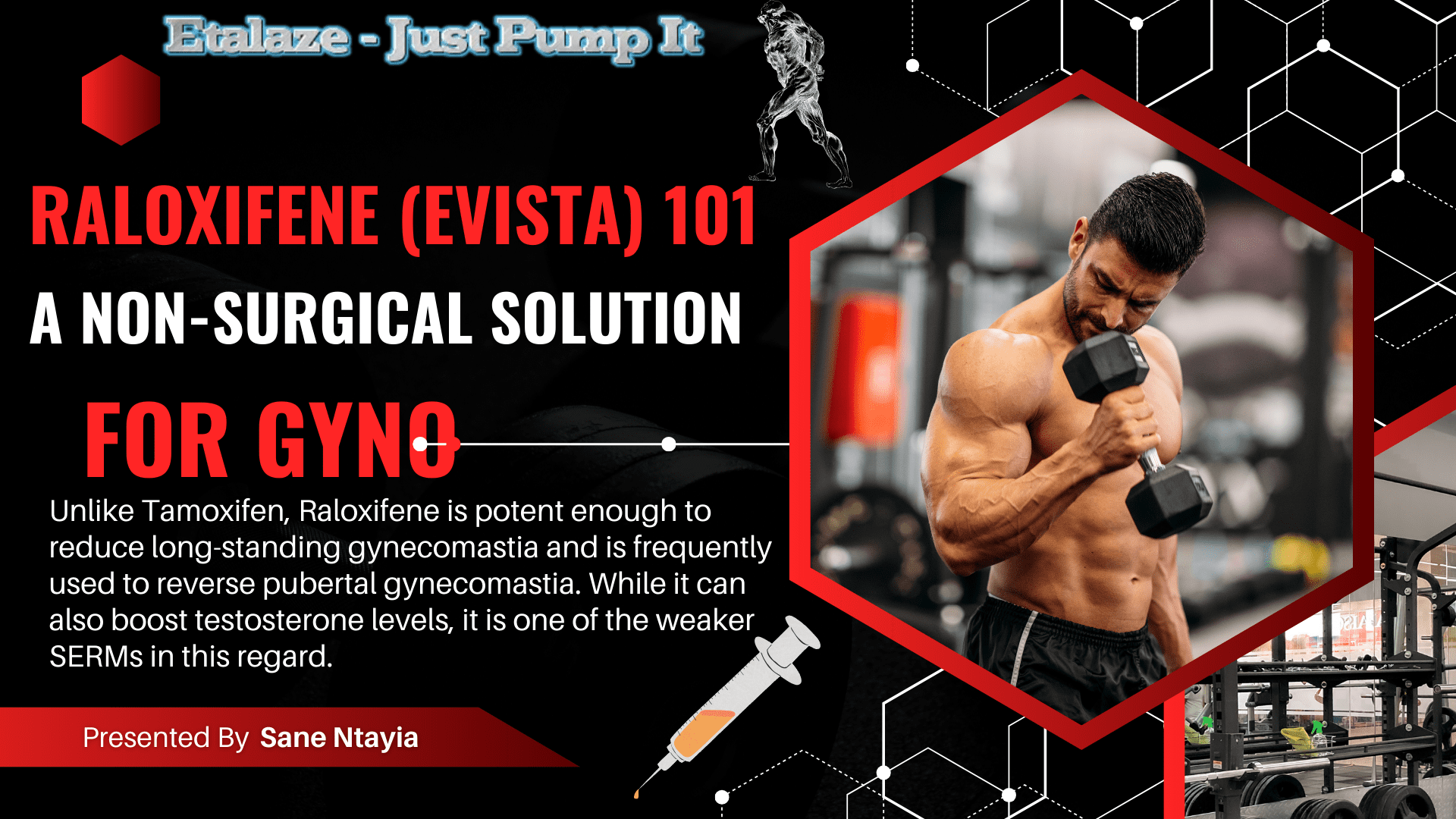
Raloxifene, a selective estrogen receptor modulator (SERM), is one of the most valuable yet less common options available today. Originally developed to prevent and treat breast cancer similar to Tamoxifen, it has gained popularity among bodybuilders seeking to prevent or eliminate gyno.
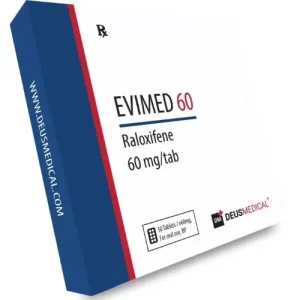 Click Here to Buy Evimed 60 by Deus Medicals
Click Here to Buy Evimed 60 by Deus Medicals
Unlike Tamoxifen, Raloxifene is potent enough to reduce long-standing gynecomastia and is frequently used to reverse pubertal gynecomastia. While it can also boost testosterone levels, it is one of the weaker SERMs in this regard.
How it Works
Raloxifene functions by blocking estrogen receptors in the breasts, which helps prevent or treat both gynecomastia and breast cancer. Additionally, it blocks estrogen receptors in the hypothalamus, stimulating testosterone production.
Beyond these primary benefits, Raloxifene can enhance bone mass, combat osteoporosis, and lower cholesterol levels.
Potential Side Effects
While Raloxifene is considered a generally safe and effective medication, like all drugs, it comes with its own set of potential side effects. One of the most notable is the reduction in Insulin-like Growth Factor 1 (IGF-1) levels. IGF-1 plays a key role in muscle growth and repair, so decreased levels could potentially impact athletic performance or recovery.
However, compared to other medications in its class, Raloxifene has a relatively low risk of causing severe liver toxicity. Users are less likely to experience harmful effects such as blood clots, mood swings, or sexual dysfunction, making it a preferable choice for many.
While rare, some users might experience less serious side effects such as hot flashes, leg cramps, or flu-like symptoms. It's essential to consult with a healthcare professional to monitor any adverse reactions and ensure the medication is being used safely.
So, despite its efficacy, Raloxifene is not without side effects, but they are typically manageable and less severe compared to other SERMs.
Check Out Halotest 10 mg, Balkan Pharmaceuticals
For gyno reversal, the typical protocol involves taking 60mg daily for 1-2 weeks, followed by 30mg daily for up to 3 months or until the condition resolves.
Read More: Joint Stiffness on AAS, How to Manage It
Typical Protocol
For gynecomastia reversal, the typical protocol involves taking 60mg of Raloxifene per day for 1-2 weeks, followed by a reduced dose of 30mg per day for up to 3 months or until the gynecomastia is resolved. In post-cycle therapy (PCT), bodybuilders generally take 60mg per day for 4-6 weeks, and then lower the dose to 30mg per day during the last week. Raloxifene is highly effective for managing gynecomastia and supporting post-cycle recovery, making it a valuable addition to a well-optimized bodybuilding regimen.
Overall
Raloxifene (Evista) is a versatile SERM used to treat breast cancer and is popular among bodybuilders for managing gynecomastia (gyno). Unlike Tamoxifen, it effectively shrinks long-standing gyno and reverses pubertal gyno. It blocks estrogen receptors in the breast and hypothalamus, thus preventing gyno and promoting Testosterone secretion. Additionally, it improves bone mass, combats osteoporosis, and lowers cholesterol levels. For gyno, take 60mg/day for 1-2 weeks, then 30mg/day for up to 3 months. For post-cycle therapy (PCT), take 60mg/day for 4-6 weeks, then reduce to 30mg/day during the final week. This safe and effective medication has minimal side effects.
Bodybuilding
Mastering Bodybuilding in 2025: Top Fitness Tips for Success
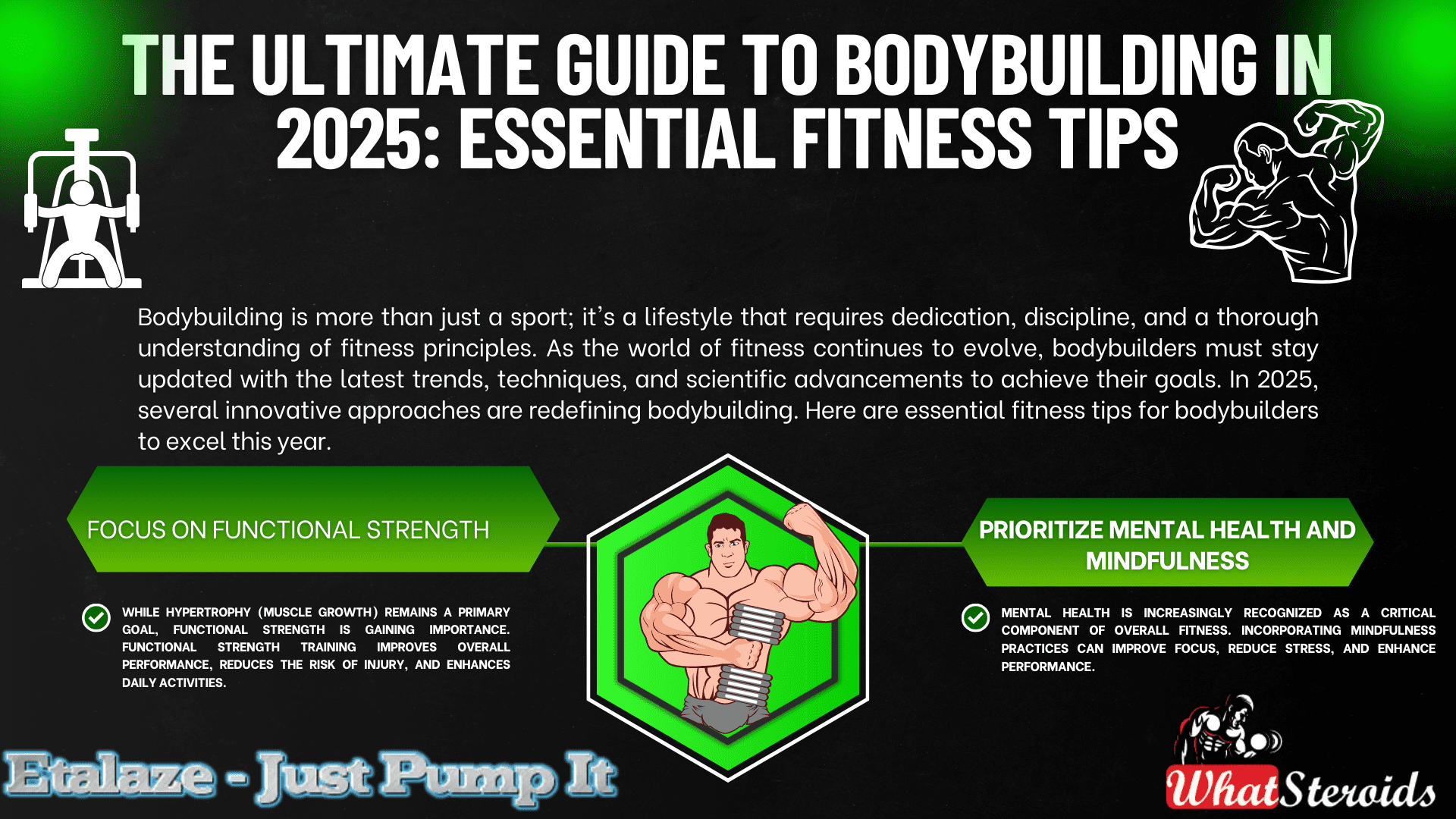
Bodybuilding is more than just a sport; it's a lifestyle that requires dedication, discipline, and a thorough understanding of fitness principles. As the world of fitness continues to evolve, bodybuilders must stay updated with the latest trends, techniques, and scientific advancements to achieve their goals. In 2025, several innovative approaches are redefining bodybuilding. Here are essential fitness tips for bodybuilders to excel this year.
Read More: Bodybuilder Winter Clothing: Staying Warm and Stylish
Embrace Technology-Driven Workouts
In 2025, technology plays a significant role in bodybuilding. Wearable devices, fitness apps, and virtual reality (VR) training are now integral components of an effective workout regimen.
Wearable Devices
Modern wearables track everything from heart rate and sleep patterns to muscle activation and caloric expenditure. Utilize these devices to monitor your progress and make data-driven adjustments to your training and nutrition plans.
Fitness Apps
Leverage fitness apps for customized workout plans, progress tracking, and virtual coaching. Many apps now incorporate artificial intelligence to provide personalized feedback and recommendations.
Virtual Reality Training
VR technology offers immersive workout experiences, allowing bodybuilders to simulate different training environments and scenarios. This can enhance motivation and add variety to your routine.
Focus on Functional Strength
While hypertrophy (muscle growth) remains a primary goal, functional strength is gaining importance. Functional strength training improves overall performance, reduces the risk of injury, and enhances daily activities.
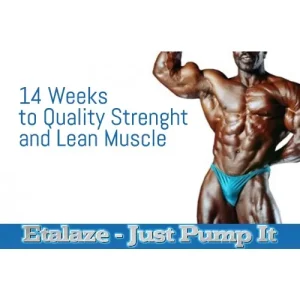 Check Out Our1 4 Weeks Quality Strength & Lean Muscles
Check Out Our1 4 Weeks Quality Strength & Lean Muscles
Compound Movements
Incorporate compound exercises like squats, deadlifts, and bench presses. These movements engage multiple muscle groups and joints, promoting balanced strength development.
Core Stability
Prioritize exercises that strengthen the core, such as planks, Russian twists, and leg raises. A strong core supports better lifting mechanics and reduces the risk of lower back injuries.
Optimize Nutrition for Muscle Growth and Recovery
Nutrition is the cornerstone of successful bodybuilding. In 2025, the focus is on personalized nutrition plans tailored to individual needs and goals.
Protein Intake
Ensure adequate protein intake to support muscle repair and growth. Aim for 1.6 to 2.2 grams of protein per kilogram of body weight per day, depending on your training intensity and goals.
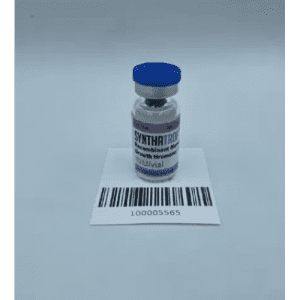 Click Here to Buy SynthaTrope By SynthaPharma
Click Here to Buy SynthaTrope By SynthaPharma
Nutrient Timing
Pay attention to nutrient timing to maximize muscle recovery and growth. Consume protein and carbohydrates within 30 minutes post-workout to replenish glycogen stores and kickstart muscle repair.
Supplements
Utilize supplements wisely. Creatine, branched-chain amino acids (BCAAs), and omega-3 fatty acids are popular choices for enhancing performance and recovery.
Prioritize Mental Health and Mindfulness
Mental health is increasingly recognized as a critical component of overall fitness. Incorporating mindfulness practices can improve focus, reduce stress, and enhance performance.
Meditation
Incorporate meditation into your daily routine to reduce stress and improve mental clarity. Mindfulness meditation can enhance your mind-muscle connection during workouts.
Visualization
Use visualization techniques to mentally rehearse your workouts. Visualizing successful lifts and achieving your goals can boost confidence and motivation.
Rest and Recovery
Prioritize rest and recovery to prevent burnout and overtraining. Ensure you get 7-9 hours of sleep per night and incorporate rest days into your training schedule.
Leverage Advanced Training Techniques
Advanced training techniques can help break through plateaus and stimulate muscle growth. In 2025, several methods are gaining popularity among bodybuilders.
Blood Flow Restriction (BFR) Training: BFR involves restricting blood flow to the muscles during low-intensity exercises. This technique can enhance muscle growth and strength without the need for heavy weights.
Eccentric Training: Focus on the eccentric (lowering) phase of exercises. Eccentric training can stimulate greater muscle damage and growth compared to traditional concentric movements.
Periodization: Implement periodization into your training plan. Varying the intensity, volume, and type of exercises can prevent plateaus and ensure continuous progress.
Incorporate Recovery and Mobility Work
Recovery and mobility are essential for preventing injuries and maintaining optimal performance. In 2025, bodybuilders are paying more attention to these aspects of training.
Foam Rolling and Myofascial Release: Use foam rollers and massage balls to release muscle tightness and improve flexibility. Regular myofascial release can reduce soreness and enhance recovery.
Stretching: Incorporate dynamic stretching before workouts and static stretching after workouts. Stretching improves range of motion and prevents muscle imbalances.
Cryotherapy and Hydrotherapy: Explore recovery techniques like cryotherapy (cold therapy) and hydrotherapy (water therapy) to reduce inflammation and accelerate muscle recovery.
Engage in Continuous Learning and Community Building
The fitness industry is constantly evolving, and staying informed is crucial for success. Engage in continuous learning and connect with the bodybuilding community for support and motivation.
Educational Resources: Read books, watch videos, and attend seminars to stay updated on the latest research and trends in bodybuilding.
Community Engagement: Join online forums, social media groups, and local bodybuilding clubs. Sharing experiences and knowledge with fellow bodybuilders can provide valuable insights and encouragement.
Professional Guidance: Consider working with a certified personal trainer or coach. Professional guidance can help you optimize your training and nutrition plans, ensuring you're on the right track.
With your FB Plus subscription or active FB Plus Pass, you now have access to 124 weeks of our most popular workout programs, which typically sell for $10-$30 each. Additionally, our popular 4-week Meal Plan is included. This is on top of the 38 Challenges and Programs that are already available to Plus members.
We've also introduced a new feature that many of you have requested. To assist you in choosing your next program, you can now preview each day of any program from its detail view. This feature lets you see all the included workout videos and content before you schedule it, ensuring you know exactly what to expect.
Conclusion
In 2025, bodybuilding is more than just lifting weights; it's a holistic approach to fitness that encompasses technology, nutrition, mental health, and advanced training techniques. By embracing these fitness tips, bodybuilders can achieve their goals, stay injury-free, and enjoy a fulfilling fitness journey. Remember, consistency and dedication are key to success in bodybuilding. Stay committed, keep learning, and most importantly, have fun on your path to becoming the best version of yourself.
-

 Steroids2 years ago
Steroids2 years agoVOX Testing: Why Bodybuilders Must Have It Tested Regularly
-

 Steroids2 years ago
Steroids2 years agoShavers and Other Body Grooming Equipment for Bodybuilders In 2023
-

 Steroids2 years ago
Steroids2 years agoChatGPT and Other Avenues to Find Great Bodybuilding Coaches
-

 Steroids2 years ago
Steroids2 years agoBest Oil Recommendations Before Competition for Subtle Shimmer
-
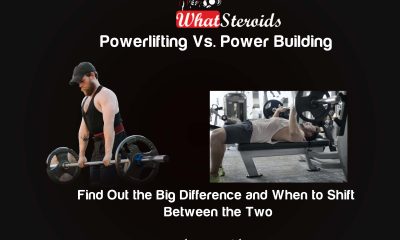
 Steroids2 years ago
Steroids2 years agoPowerlifting Vs Power Building: Find Out the Big Difference and When to Shift Between the Two
-

 Nutrition1 year ago
Nutrition1 year agoEverything Nutritional Food: What’s Too Much Or Too Little
-

 Anabolic Steroids1 year ago
Anabolic Steroids1 year agoLegality of Anabolic Steroids In Latin America
-
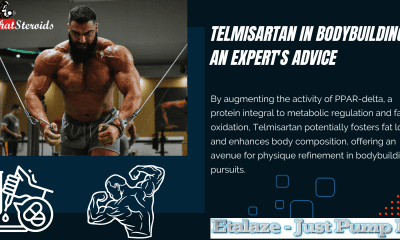
 Bodybuilding Products12 months ago
Bodybuilding Products12 months agoTelmisartan In Bodybuilding: An Expert’s Advice
-

 Beginners2 years ago
Beginners2 years agoTren Cycle for Beginners
-
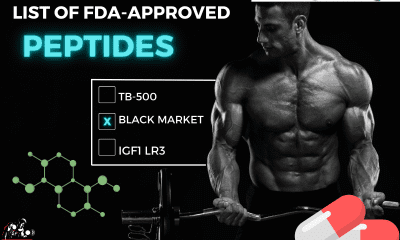
 Bodybuilding1 year ago
Bodybuilding1 year agoList of FDA-Approved Peptides
-
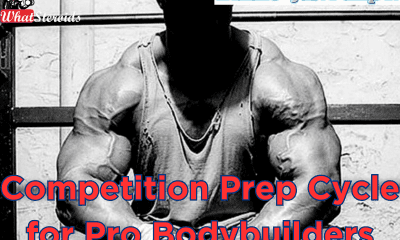
 Bodybuilding2 years ago
Bodybuilding2 years agoCompetition Prep Cycle for Pro Bodybuilders
-

 Bodybuilding1 year ago
Bodybuilding1 year agoChia Seeds in A Bodybuilder’s Diet: An Expert’s Advice
-

 Anabolic Steroids11 months ago
Anabolic Steroids11 months agoHow Much Do You Know About B-AET? A Fat Burner You’ve Been Missing
-
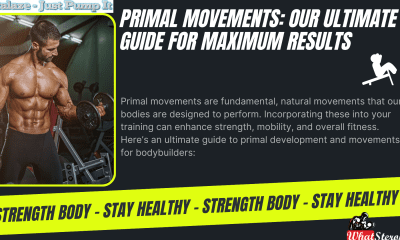
 Bodybuilding7 months ago
Bodybuilding7 months agoPrimal Movements: Our Ultimate Guide for Maximum Results
-
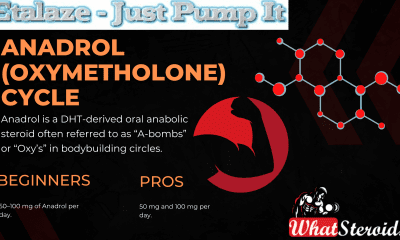
 Steroids11 months ago
Steroids11 months agoAnadrol Cycle: Benefits, Doses, Alternatives, etc.
-

 Anabolic Steroids8 months ago
Anabolic Steroids8 months agoJoint Stiffness: How to Manage It While on AAS
-

 Product Reviews10 months ago
Product Reviews10 months agoTop Vitamins for Skin Health
-
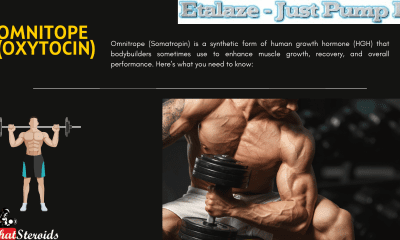
 Steroids9 months ago
Steroids9 months agoOmnitope (Oxytocin)
-

 Bodybuilding1 year ago
Bodybuilding1 year agoHow Much Is Too Much Cardio? Understanding Heart Rate Zones
-
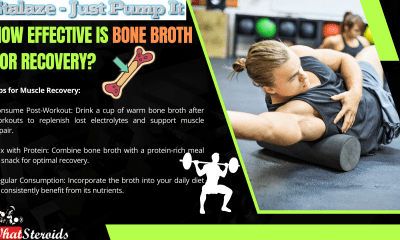
 Bodybuilding8 months ago
Bodybuilding8 months agoHow Effective is Bone Broth for Recovery?
-
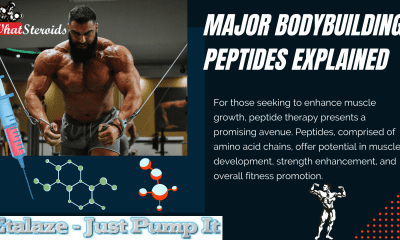
 Steroids10 months ago
Steroids10 months agoMajor Bodybuilding Peptides Explained
-
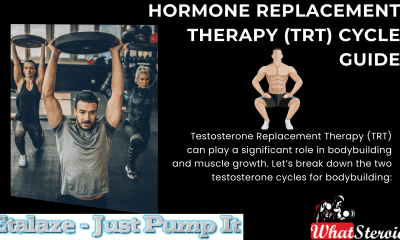
 Bodybuilding9 months ago
Bodybuilding9 months agoHormone Replacement Therapy (TRT) Cycle Guide
-
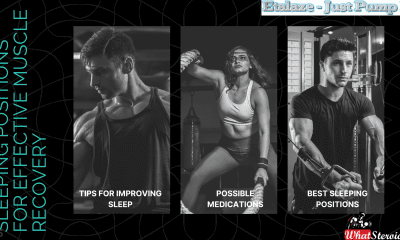
 Steroids8 months ago
Steroids8 months agoSleeping Positions for Effective Muscle Recovery
-

 Anabolic Steroids1 year ago
Anabolic Steroids1 year agoStart The New Year Strong With These Tips
-

 Bodybuilding10 months ago
Bodybuilding10 months agoHere Is How To know Your MRV (Maximum Recoverable Volume)

